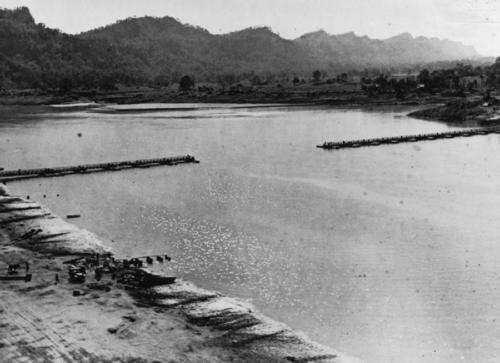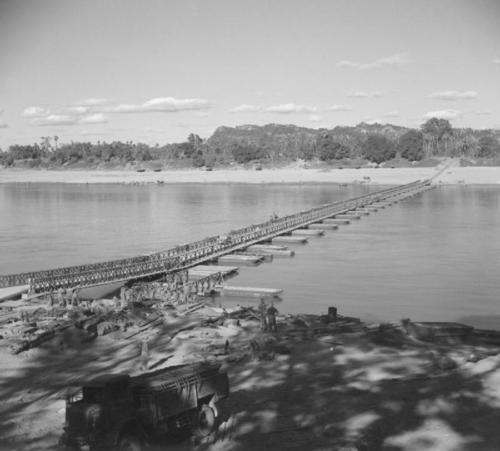What were the events immediately following Dinshaw Eduljee's crash? Could his crashed plane have been found by Allied troops?
During his last reconnaissance mission on November 27, 1944, the report of what the and his wingman observed (likely reported by his wingman included sighting "Own troops at RU 903817 (about 7 miles to the north of Sizwe and the crash-site)".
By December 2, 1944, Allied troops had taken Kalewa 7 miles to the NNW of Sizwe and on the Chindwin River's west bank.
By December 8, 1944 Allied troops had crossed the Chindwin at Kalewa, likely in the Shwegyin area given that the Shwegyin-Pyingaing road started there. Sizwe and the crash-site were on that road. Given the accounts related below, Allied troops could have reached the crash site by mid-December. Further, since there was an Japanese camp close to the crash site, the advancing Allied troops would either have stormed the camp and checked it out for stranglers and intelligence.
There is a good chance Allied troops came across the crashed plane about three weeks after the crash. If so, could the troops who came across the crash have maintained records of what they saw? Below, we read mention of the 5th Indian Infantry Division being involved in the battles around Kalemyo and Kalewa. We also read of the 19th Indian Division and the 11th East African Division crossing the Chindwin River, the latter at Kalewa.
As we had mentioned in a previous page, according to Dinshaw Eduljee's brother, Major (Retd.) Erauch (Eddie) Eduljee, not too long after the crash, Phiroze Noble (of the Sikh Regiment?) came across Dinshaw's crashed Hurricane with its left wing detached. There were no bullet holes, no fire damage, no blood stains and no signs of any struggle. A helmet was on the seat as if placed there – not thrown there. No body was ever found.
Yezdi Chinoy, Dinshaw Eduljee's great nephew, has determined that a Lt. Col. Phiroze K. Noble was transferred to the 4GR [4th Gorkha Rifles] in 1947 (at a time when Indian officers like Sam Maneckshaw were for the first time assigned to the Gorkha Rifles). Noble's number, IC 1099, indicates that he was a senior member of the Indian Army. Noble's date of demise is stated as November 18, 1982.
The Courier-Mail newspaper from Brisbane, Australia notes (by-line dated December 8, 1944 AAP), "The Japanese are putting up strong resistance to Allied troops in positions two miles north-east of Kalewa on the Chindwin front, in Burma. Kalewa itself has been bombed heavily by Allied planes. East African troops continue to cross the Chindwin and tighten their hold on the east bank of the river." Thus it would seem that by December 8, 1944, Allied troops had crossed the Chindwin in the Shwegyin area very close to Dinshaw Eduljee's crash site.
The units of the Allied/Commonwealth forces that may have come across the wreckage of Dinshaw Eduljee's crashed aircraft could have been unit of the 5th Indian Infantry Division: 9th Indian Infantry Brigade and 161 Indian Infantry Brigade which were involved in the battles around Kalemyo and Kalewa. The 9th Brigade had 2 West Yorks, 3/2 Punjab (still in the Indian Army), 4 J&K (Jammu & Kashmir) Infantry (still in the Indian Army). The 161 Brigade had 4 Royal West Kents, 1/1 Punjab (now in the Pakistam Army), 4/7 Rajput (still in the Indian Army). [cf. Chapter 26 of Antony Brett-James' book, Ball of Fire, The Fifth Indian Division in the Second World War.
A Curious Narrative and Post Script
Dinshaw Eduljee's younger brother and this author's father, Major E. F. Eduljee (who had joined the Indian Army at about the time of Dinshaw's crash), travelled to Japan as part of the Allied occupation forces. Sometime around 1946, while in Tokyo?, he met an ex-Japanese officer turned artist at an exhibition of the latter's artwork. They got talking about Dinshaw's crash and the Japanese ex-officer made some enquiries. The results of the enquiry were that the Japanese Army had turned Dinshaw over to the Indian National Army - an anti-British movement who had allied themselves with the Japanese with the hope of securing India's independence from Britain. Dinshaw died while in their custody. While the cause of his death was not recorded, the officer stated Dinshaw had not been executed. The INA cremated Dinshaw's body and the ashes had been placed in a Shinto temple (in Japan?). Doubting the account's authenticity, Maj. Eduljee did not give it any credence and did not follow up the information.
 |
| Map of Burma showing the Kalewa (Kalwa)-Shwegin (Shwegyin) area circled in red. Photo credit: ibiblio.org |
Bridge Across the Chindwin River at Kalewa
The following is an excerpt from Military Bridging – World War II (The Far East):
"Lead elements of the 19th Indian Division crossed the Chindwin using ferries in November 1944 and by the end of the month the entire division had established a strong bridgehead, able to provide protection for the 11th East African Division and the rest of the Fourteenth Army to cross.
"The Chindwin is a wide River and a ferry would not be sufficiently capable to support the planned forces crossing in good order so a bridge was planned. This was to be a Class 30 Bailey pontoon with a backup of a Class 12 Bailey pontoon should the heavier bridge not make it forward.
 |
| A view of the 1,100ft bailey bridge across the Chindwin River as it nears completion, less than 12 hours after the 14th Army captured Kalewa, 2 December 1944. Image credit: IWM (SE 835) |
"By the beginning of December all the bridging stores were in place, four sets of 130 ft double-double Bailey, four sets of Class 40 Bailey rafts and many pontoons, cordage, Somerfield and coir matting and other construction materials.
"On the 6th, work commenced; 67, 76 and 361 Field Companies Indian Engineers, 332 Field Park Company Indian Engineers, a company of the Pathan Engineers Battalion, 852 and 854 Bridge Companies Indian Engineers, under the command of Colonel Seymour-Williams.
"Construction of some elements of the bridge took place upstream where there was less danger of Japanese artillery and working conditions for vehicles were better. The construction site was protected by barrage balloons bought up from Calcutta. Grub Bridge, as it was called, after Colonel Seymour-Williams son, was open for traffic 4 days later and the first vehicle crossed on the afternoon of the 10th December 1944."
 |
| The completed Bailey bridge over the Chindwin River near Kalewa, December 1944. The hillock at Sizwe where Dinshaw Eduljee crashed his plane was 5.5 km directly east of the river. Image credit: IWM (SE 835) |
 |
| Men of the Border Regiment on a ferry ready to cross the Chindwin River, between Kalewa and Shwegyin January 1945. Note the Sikh soldiers. Image credit: IWM (SE 1883) |
 |
| Men of the 11th East African Division come ashore at Kalewa having just crossed the Chindwin River by ferry, January 1945. Note the multi-national make-up of the men in the picture including Sikhs. Image credit: IWM (SE 1899) |
No comments:
Post a Comment